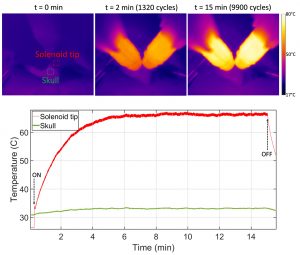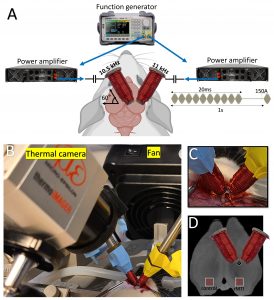Goal: Investigating novel neuromodulation modalities
The clinical use of transcranial magnetic stimulation (TMS) has been a prominent achievement in the field of neuroscience in the past two decades. In this research, to improve stimulation depth and focality, we propose a novel TMS technique which we call magnetic temporal interference (MTI). MTI relies on two magnetic solenoids that are driven at two slightly different high frequencies. Non-target regions of the brain are impacted only by one high-frequency magnetic field which alone is ineffective at recruiting neural activity, while on-target regions are impacted by two fields that interfere to create a low-frequency envelope. Therefore MTI systems can stimulate deep regions in the brain without
activating the overlying tissues. We have successfully demonstrated this concept using COMSOL simulations and shown some validation in small animal models.
  |
 |
 |
Future Work:
- We are working on developing the technology for larger animal models using larger solenoids/coils that can target deep brain regions.
Collaborators: Sun Nian (NU), Jennifer Rodger (UWA), Sydney Cash (MGH & Harvard Medical School)
Related Publications